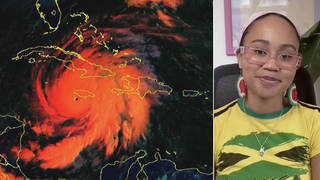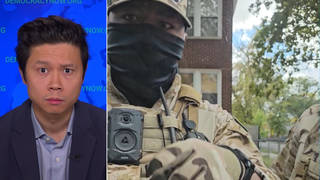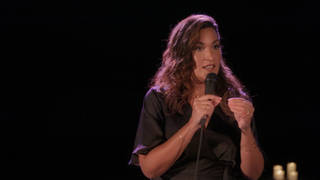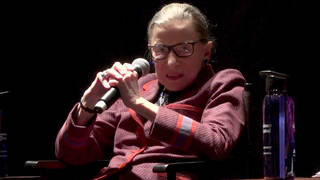
Guests
- Betsy Westco-director of RBG and a 21-time Emmy winner for her work as an ABC News producer. She also teaches at the Columbia School of Journalism.
- Julie Cohenco-director of RBG and a longtime filmmaker who has made eight documentaries. She was the creator of Court TV’s Supreme Court Watch.
One of the most talked-about documentaries at this year’s Sundance Film Festival looks at the groundbreaking life of the nearly 85-year-old Supreme Court Justice Ruth Bader Ginsburg. 2018 marks her 25th year on the court, and she has no plans to retire. Ginsburg first gained fame in the 1970s when she co-founded the Women’s Rights Project at the American Civil Liberties Union, where she argued six gender discrimination cases before the Supreme Court. In recent years, Ginsburg’s public profile has soared as the court has swerved to the right. Ginsburg often now finds herself on the dissenting side of opinions. We feature excerpts from the new film and speak with its directors, Julie Cohen and Betsy West.
Transcript
AMY GOODMAN: 2018 marked Ruth Bader Ginsburg’s 25th year on the U.S. Supreme Court. We’re joined now by the directors of the film, Julie Cohen and Betsy Wright. Julie is a longtime filmmaker who’s made eight documentaries and was the creator of Court TV’s Supreme Court Watch. Betsy West is a 21-time Emmy winner for her work as an ABC News producer, who now teaches at the Columbia School of Journalism.
Julie Cohen and Betsy Wright [sic], it is so great to see you—Betsy West, it is so great to see you both. Julie, why don’t you start off by talking about why you decided to take on Ruth Bader Ginsburg as the subject of your film? Why did you decide to follow her?
JULIE COHEN: You know, “How could you not?” is almost a question with RBG. Betsy and I had each, individually, for separate projects, done interviews with her several years ago. We had followed her kind of stellar rise to rockstardom, as young women began to sort of idolize her as the Notorious RBG. And we just felt like, “You know, someone ought to do a full-dress, serious documentary covering this extraordinary woman’s life. And why not have it be us?”
AMY GOODMAN: So, Betsy West, you’ve covered many different issues, and one of the things you’ve done most recently is the Makers series, women making a difference. So, Ruth Bader Ginsburg, you—both you and Julie had interviewed her separately.
BETSY WEST: Yes, yes.
AMY GOODMAN: And what most strikes you about her? If you can begin by sort of giving us a nutshell description of Ruth Bader Ginsburg, the Supreme Court justice?
BETSY WEST: Well, when you meet her in person, she’s a very tiny person. And yet she has a kind of commanding presence. I think it’s the contrast about her that really strikes you. She’s a very serious person, the kind of person, if you say, “Hey, how are you?” she doesn’t immediately jump in to tell you how she is, she thinks about it. She’s very deliberate in everything she says. So, as she said to us in the interview, “I tend to be rather sober.” On the other hand, she has a fabulous sense of humor. And as we discovered in the film, she loves to laugh. And so, she’s a very—she’s a multidimensional person, with an extraordinary life story.
AMY GOODMAN: And I want to talk about that life story. I want to first, though, go to a clip from your documentary, RBG, where Justice Ginsburg talks about the first time she argued before the Supreme Court, in the case Frontiero v. Richardson in 1972. The case centered on a female Air Force lieutenant who had been denied the same housing and medical benefits as her male colleagues. Justice Ginsburg, then the lawyer Ginsburg, argued the Air Force’s statute for housing allowances treated women as inferior, and the Supreme Court ruled in her favor, eight to one.
JUSTICE RUTH BADER GINSBURG: There was not a single question. I just went on speaking. And I, at the time, wondered, “Are they just indulging me and not listening, or am I telling them something they haven’t heard before, and are they paying attention?”
BRENDA FEIGEN: The justices were just glued to her. I don’t think they were expecting to have to deal with something as powerful as a shear force of her argument, that was just all-encompassing. And they were there to talk about a little statute in the government code. I mean, it was just—we seized the moment to change American society.
RUTH BADER GINSBURG: In asking the court to declare sex a suspect criterion, we urge a position forcibly stated in 1837 by Sarah Grimke, noted abolitionist and advocate of equal rights for men and women. She said, “I ask no favor for my sex. All I ask of our brethren is that they take their feet off our necks.”
AMY GOODMAN: An excerpt from RBG, the documentary that’s just aired at the Sundance Film Festival to much acclaim. In that clip, we also heard from Brenda Feigen, who was co-director, with Ruth Bader Ginsburg, of the ACLU’s Women’s Rights Project. So, Julie Cohen, let’s talk about her life before she was the Notorious RBG, before she was Supreme Court justice.
JULIE COHEN: Sure. I mean, you know, that was one of the big factors making us want to make this film. A lot of the people that love her and think she’s cool and know about her dissents don’t really know the full story and don’t appreciate how much she achieved for women’s equal rights under law in her career as a lawyer, particularly during those times at the Women’s Rights Project in the 1970s.
Basically, she took on a number of cases. There were six, including that one you just played, Frontiero, that she argued before the Supreme Court, winning five of them, making the case at a time when that case wasn’t widely understood or even—you know, it was sort of hard for society and the male justices of the time to register the idea that, “Oh, wait, the Constitution should provide equal rights for men and women?” This was—she was following up on what Thurgood Marshall had done sort of the decade earlier—basically, a slow legal march for civil rights for people of all races—and she was applying that idea to gender and had extraordinary success with it.
AMY GOODMAN: I wanted to go to another clip. Ruth Bader Ginsburg, nominated by President Clinton in 1993. This is during her Senate confirmation hearing, when she openly defended—and this was highly unusual—openly defended a women’s right to have an abortion.
JUDGE RUTH BADER GINSBURG: This is something central to a woman’s life, to her dignity. It’s a decision that she must make for herself. And when government controls that decision for her, she’s being treated as less than a fully adult human responsible for her own choices.
AMY GOODMAN: During Ruth Bader Ginsburg’s 1993 Supreme Court confirmation hearing, Republican Senator Orrin Hatch of Utah questioned her stance on abortion.
SEN. ORRIN HATCH: The so-called constitutional right to abortion, a right which many, including myself, think was created out of thin air by the court—
JUDGE RUTH BADER GINSBURG: But you asked me—
SEN. ORRIN HATCH: Yeah.
JUDGE RUTH BADER GINSBURG: —the question in relation to the Supreme Court’s precedent. And you now ask me another question in relation to the Supreme Court’s precedent. The Supreme Court’s precedent is that access to abortion is part of the liberty guaranteed by the—
SEN. ORRIN HATCH: Well, that was just to be affirmed by—
JUDGE RUTH BADER GINSBURG: —the 14th Amendment.
AMY GOODMAN: That 1993 confirmation hearing, Betsy West, how unusual, especially in light of now, in 2018? Imagine hearing a Supreme Court justice being so open about her support for freedom to choose for women, about her support for abortion. Talk about the significance of this.
BETSY WEST: She was extremely forthright about this. She’s a very principled person, and she was not going to pull her punches on this. I mean, the amazing thing is that, after that, she was confirmed 96 to 3. I know.
AMY GOODMAN: Ninety-six to three.
BETSY WEST: To three. And you heard, I mean, Orrin Hatch basically saying, “Look, we disagree, but I think you’re well qualified to serve on the Supreme Court. And you’ve been nominated by our president, who happens to be a Democrat. That’s the way this system works.” It’s kind of poignant and extraordinary to hear that, you know, today.
AMY GOODMAN: You both interviewed Orrin Hatch. I mean, you interviewed him for the film.
BETSY WEST: Yes, yes.
AMY GOODMAN: Did he say he would support her today? I mean, he was very laudatory of her.
BETSY WEST: Yes. Yes, he was. First of all, he said, “I love Ruth Bader Ginsburg.” He said that. I was like, “What?” Really, he admires her so much. He admires her brain, and he admires her character, what she stands for. And he said, “Look, I think it’s a good thing for the court to have an articulate, smart liberal on the court.” He said, “I think it elevates the entire conversation, the debate.” I was surprised by how forceful and strong he was in his ongoing support for her.
AMY GOODMAN: And talking about relationships that might surprise some, her relationship, Julie Cohen, with Justice Scalia and the significance of this, the history of this, before Scalia died?
JULIE COHEN: Yes. I mean, Justice Scalia and Justice Ginsburg were quite close, going back to their days together on the U.S. Court of Appeals for the D.C. Circuit in the 1980s, admired each other as kind of intellectual sparring partners and really liked and loved each other as friends. They both loved opera. They both had a lot of other intellectual interests, in theater, in literature. And the fact that they disagreed so vehemently on the law, extraordinarily, seemed to have made them closer to one another. They don’t—you know, they didn’t deny that it sometimes wasn’t exactly pleasant. You know, after—one example that the justice has talked about is, you know, after Bush v. Gore, when they were like—you know, couldn’t have been more opposed to each other’s point of view, when the stakes couldn’t have been higher, at one point, at the end of the evening, he gave her a call and said, “Ruth, you know, go home and take a hot bath, and we’ll see each other again in the morning.” And, you know, it’s a kind of—
AMY GOODMAN: And for those who aren’t familiar with Bush v. Gore, though they may have been familiar—become familiar with the results?
JULIE COHEN: Yes. The Supreme Court decision that ended the recount in Florida and led to George W. Bush becoming president of the United States.
AMY GOODMAN: Being chosen as president by the U.S. Supreme Court.
JULIE COHEN: By the U.S. Supreme—
BETSY WEST: And she dissented.
JULIE COHEN: Right.
BETSY WEST: Yes.
JULIE COHEN: Justice Scalia was one of the—one of the architects of the majority decision, saying—having George Bush become the president. And Ruth Ginsburg wrote a—wrote one of several—I think there were a number of dissents in that case, but was one of the dissenters in that case.
AMY GOODMAN: And this issue of Ruth Bader Ginsburg being the dissenter, young people who are following her now, that’s all they would think about. But that actually wasn’t always the case. And you have a really interesting sort of image that you have in the film, RBG, where you show her right in the center there, you know, much closer to the conservatives, and then how she moves to the left. Betsy West?
BETSY WEST: Yeah, as one of our interviewees said, she was never meant to be the great dissenter. She always wanted consensus. And she still wants consensus. She has a very practical view of the law, and she’s always trying to bring people over to her side. It’s very important to her that she have collegial relationships with her fellow justices and that she makes reasoned arguments. She’s not a bomb thrower. However, when push comes to shove and she feels that the Constitution is not being followed, she’s not afraid to issue a very scathing dissent. And as she says, “Look, I’d rather be in the majority. But when I’m not, I will write a dissent.”
AMY GOODMAN: And she’s got the doily collars. That’s what I call them, because they look like doily.
BETSY WEST: Yeah.
AMY GOODMAN: The different ones.
JULIE COHEN: Jabot.
AMY GOODMAN: What did you say?
JULIE COHEN: Yes, jabot is the name of them.
AMY GOODMAN: Oh, excuse me. Excuse me.
BETSY WEST: They call them—they call them jabot. She and Sandra Day O’Connor came up with this together. And, yes—
AMY GOODMAN: And she’s got the different ones for when she’s in the majority opinion—
BETSY WEST: Yes.
AMY GOODMAN: —or when she’s expressing the dissent.
BETSY WEST: The dissent, yes. It’s her—she has a great fashion sense, and she brings her fashion sense to her clothing on the Supreme Court.
JULIE COHEN: And, you know, when Supreme Court justices come out to read opinions, it’s not publicly known yet what the decision is going to be. So, if you’re in the courtroom—of course, there aren’t cameras in the courtroom, but if you’re in the courtroom, you get a preview a few minutes earlier, because from Justice Ginsburg’s collar, if she’s going to read an opinion and she’s wearing that lovely sort of black, sparkly, fan-shaped collar, you know she’s about to deliver a dissent.
AMY GOODMAN: We’re going to go to a break, and then we’re going to come back and hear a really interesting comment from Justice Ginsburg just yesterday. She spoke at the Filmmakers Lodge. She was interviewed by NPR’s Nina Totenberg, and she talks about this seminal, foundational work of Catharine MacKinnon and how it changed her view also of women’s rights and what the whole issue of gender harassment is all about. This is Democracy Now! We’re talking about a film that just premiered at the Sundance Film Festival. It’s called RBG and is about the Supreme Court Justice Ruth Bader Ginsburg. Stay with us.
[break]
AMY GOODMAN: This is Democracy Now!, democracynow.org, The War and Peace Report. I’m Amy Goodman. We’re broadcasting from the Sundance Film Festival in Park city, Utah, and we will be here for the week. Yes, from the Sundance Film Festival, where a film about Supreme Court Justice Ruth Bader Ginsburg called RBG has just premiered. Well, before the film, on Sunday, Justice Ginsburg, who flew in to Park City, Utah, this weekend, was interviewed by NPR’s Nina Totenberg, a dear friend of Ruth Bader Ginsburg. Totenberg asked Ginsburg if she had ever been sexually harassed herself. This was the Supreme Court justice’s answer.
JUSTICE RUTH BADER GINSBURG: The answer is yes. Every woman of my vintage knows what sexual harassment is, although we didn’t have a name for it. The attitude to sexual harassment was simply “Get past it. Boys will be boys.”
Well, I’ll give you just one example. I’m taking a chemistry course at Cornell, and my instructor said—because I was uncertain of my ability in that field—he said, “I’ll give you a practice exam.” So he gave me a practice exam. The next day, on the test, the test is the practice exam. And I knew exactly what he wanted in return. And that’s just one of many examples.
This was not considered anything you could do something about, that the law could help you do something about, until a book was written by a then-young woman named Katie MacKinnon—Catharine MacKinnon. And it was called Sexual Harassment in the Workplace [Sexual Harassment of Working Women]. And I was asked to read it by a publisher and give my opinion on whether it was worth publishing. It was a revelation. The first part described incidents like the one I just mentioned. And the next was how this anti-discrimination law, Title VII, which prohibits discrimination on the basis of race, national origin, religion and sex—how that could be used as a tool to stop sexual harassment. It was eye-opening, and it was the beginning of a field that didn’t exist until then.
NINA TOTENBERG: So, just to close the loop here for a minute, what did you do about the professor? Did you just stay clear of him? What did you do?
JUSTICE RUTH BADER GINSBURG: I went to his office, and I said, “How dare you! How dare you do this!” And that was the end of—the end of that.
NINA TOTENBERG: I assume you did quite well on that exam.
JUSTICE RUTH BADER GINSBURG: Well, I deliberately made two mistakes.
AMY GOODMAN: Supreme Court Justice Ruth Bader Ginsburg, speaking with NPR’s Nina Totenberg, a woman who has interviewed her for decades. They’ve known each other for 40 years. And she is one of the people interviewed in the new documentary about Ruth Bader Ginsburg, that will go throughout the week, called RBG. Our guests, again, are the film’s directors and producers, Julie Cohen and Betsy West.
Betsy West, the significance of what Justice Ginsburg said, saying that Catharine MacKinnon was so seminal?
BETSY WEST: Well, I had never heard her talk about this, but it’s absolutely true that there really was no word for sexual harassment, when Ruth Bader Ginsburg was being discriminated against as a young woman, and then, later, all of the women who flooded into the workplace in the '70s just sort of felt like, “Hey, this is the price of entry, something we've got to put up with in order to have these fantastic jobs.” And it was Catharine MacKinnon, who was really just a young—just out of law school. She may still have been in law school, when she started working on this concept and wrote this paper, that was absolutely seminal and, in fact, was quoted by the Supreme Court in the mid-'80s, parts of her—some of the exact language that she used. And as Ruth Bader Ginsburg said, it was a revelation: “Hey, this is wrong, and it's actually unconstitutional.” That’s something that I think a lot of people don’t understand.
AMY GOODMAN: And, you know, we can’t talk about your film, RBG, without talking about her family, her relationships, and particularly her husband, who was also a well-known lawyer. Julie Cohen, if you can talk about this love story, that lasted for over half a century?
JULIE COHEN: Yeah, I mean, the love and marriage between Ruth and Marty Ginsburg is sort of like—it’s not just romantic, but it’s—I think it’s really an inspirational part of a feminist story. Ruth Bader Ginsburg would say—often the way like a super-successful man talks about his wife, she’ll say she wouldn’t have gotten where she got, without him pushing. And it’s absolutely true. They met at Cornell, where they were both students. They fell madly in love. Marty Ginsburg—Ruth Bader Ginsburg said he was the first guy who even seemed to notice that she had a brain.
BETSY WEST: That’s because she was so beautiful, by the way.
JULIE COHEN: Because she was so beautiful, by the way, yes. And he basically—although he was an incredibly successful tax attorney in his own right, he really devoted a lot of his life both to the family—he was the primary cook, and he certainly shared child care responsibilities with her—and then he devoted a fair amount of his time and energy to pushing her career forth. She’s not the type to go around self-promoting. He was not shy about promoting her.
AMY GOODMAN: And talk about that, because we just played that clip of President Clinton nominating her, but how did that happen? How did Ruth Bader Ginsburg come to Clinton’s attention? He certainly—she wasn’t the old one he was looking at.
BETSY WEST: Yeah, I mean, Clinton himself had—says that he wanted to nominate Governor Cuomo. Cuomo didn’t want to do it. And then he started looking around, and possibly, probably—yes, definitely, because of the Marty Ginsburg campaign and others of her supporters who just felt that she was a legal giant, her name came to his attention. But as he says, Marty Ginsburg wasn’t the only person lobbying for somebody. And when he met her in person, he told us that within 15 minutes of their conversation, he knew he was going to nominate her. It was kind of a meeting of the minds about the law, the best way to make law. And so, he was really taken by her. She was 60 years old when she was nominated. That was actually kind of on the old side. But he decided that she deserved it.
AMY GOODMAN: I want to turn to the 2007 Ledbetter v. Goodyear Tire & Rubber Co. pay discrimination case, the Supreme Court rejecting Lilly Ledbetter’s claim of pay discrimination at a Goodyear tire plant in Alabama, where she worked as an overnight supervisor for 19 years. The decision moved Justice Ruth Bader Ginsburg to read her dissent from the bench, a relatively rare move reserved to criticize the majority opinion. This is part of Justice Ginsburg’s dissent.
JUSTICE RUTH BADER GINSBURG: In our view, the court does not comprehend or is indifferent to the insidious way in which women can be victims of pay discrimination. Title VII was meant to govern real-world employment practices, and that world is what the court ignores today. Pay disparities often occur, as they did in Ledbetter’s case, in small increments. Only over time is there strong cause to suspect that discrimination is at work.
AMY GOODMAN: So, the Lilly Ledbetter Fair Pay Act later passed in response to the Supreme Court. The significance, Julie?
JULIE COHEN: Well, I mean, the Lilly Ledbetter Fair Pay Act was a very important piece of legislation. And the significance in the RBG story is reminding you that, yes, of course, a key role of a Supreme Court justice and what you think of as maybe their greatest potential for accomplishing change is in a majority opinion they write, but Justice Ginsburg really made a huge difference in our laws by the dissent that she wrote in Lilly Ledbetter, not only where she explained the unfairness of the statute of limitations that had been placed on how long a woman could wait to make a claim about being paid unequally, but her dissent, she just came right out and said, like, “The ball is now in Congress’s court. Like, you know what? Maybe we’re a little stuck here on the judicial side. Congress, take some action here.” And Congress took her up on it, and the law was passed and signed into law—actually, the first piece of legislation that President Obama signed, when he was inaugurated in January 2009.
AMY GOODMAN: At Sunday’s interview that NPR’s Nina Totenberg did with Justice Ginsburg, she pointed out that Justice Ginsburg had hired clerks through the 2020 term, and asked her about how long she’ll stay on the court.
JUSTICE RUTH BADER GINSBURG: My current answer, the answer that will continue to be my answer: As long as I can do the job full steam, I will be here.
AMY GOODMAN: So, that’s Justice Ruth Bader Ginsburg. Betsy West, she has chosen her clerks through the 2020 term.
BETSY WEST: Think she’s sending a signal? Yes, she seems very determined to continue doing the job that she loves. I mean, one of the most—
AMY GOODMAN: A survivor of pancreatic cancer—
BETSY WEST: Cancer.
AMY GOODMAN: —and colorectal cancer.
BETSY WEST: Colorectal cancer. One of the most amazing scenes for us was filming her in her gym with her trainer, where she works out twice a week. She does a grueling one-hour workout, without fail. She is—well, and the workout involves, you know, planks, push-ups, medicine ball, the whole routine.
AMY GOODMAN: It’s the new Jane Fonda workout video I’m expecting to see.
BETSY WEST: Yeah, I mean, 85 is the new 45. Who knows? I mean, she is determined to keep herself in shape.
AMY GOODMAN: We have 10 seconds, Julie. What most surprised you in meeting Justice Ginsburg and doing this documentary?
JULIE COHEN: You know, there are a lot of legends that have arisen about Justice Ginsburg over the past couple years, as she’s become the Notorious RBG, including the workout, including her long work hours. I think the surprise was that most of those legends are true.
AMY GOODMAN: Well, I want to thank Julie Cohen and Betsy West, directors and producers of the documentary RBG, which just had its world premiere here at the Sundance Film Festival.












Media Options